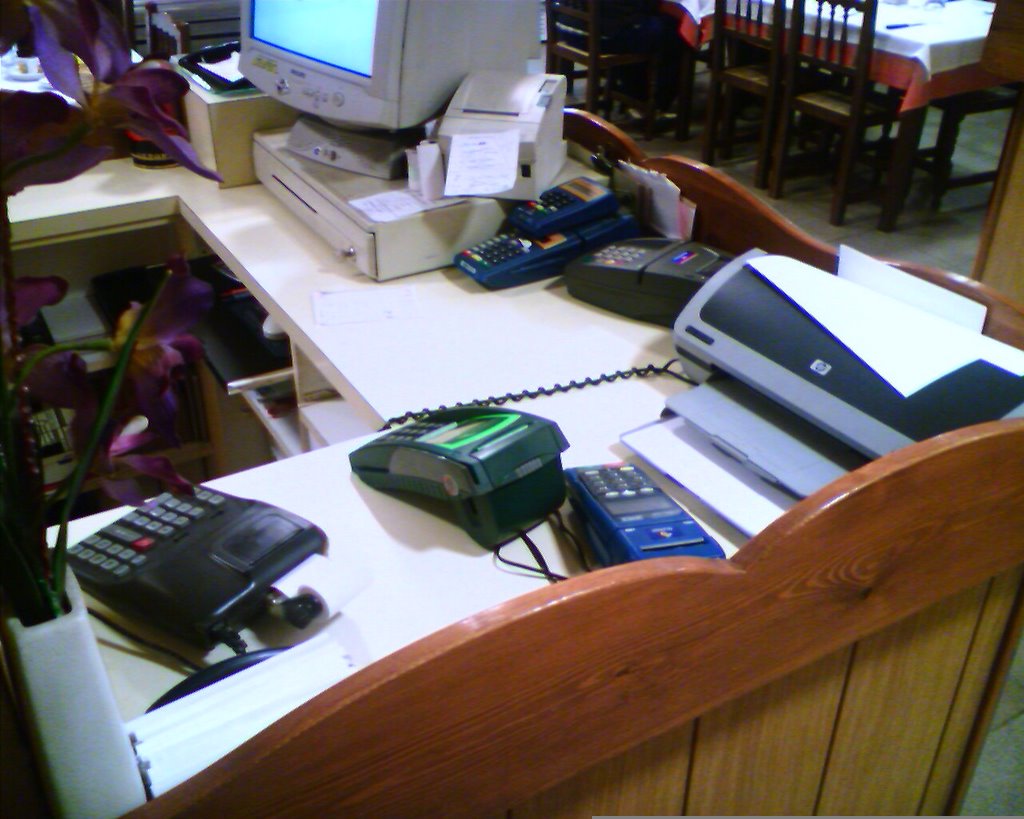In 2005 I visited my father in France. It turned out to be convenient to pick me up from the Gerona airport in Spain. And as we had enough time, we had lunch in La Jonquera.
At the restaurant’s checkout I noticed a peculiar array of devices: there were four payment terminals.

I’d never seen that. From what I know, a merchant works with a bank which handles all their payments. Apparently not over here.
A closer inspection revealed that each was associated with a different bank. So apparently, depending on the bank that a customer of the restaurant works with, the restaurant needed to have a payment terminal associated with that.
To me, this does not sound optimal for the merchant. It takes money and on the desk to accommodate all those different payment networks. And if you have only one terminal many customers can’t pay by card. That won’t make them happy, and the last thing you want as a merchant is to have unhappy customers.
An online payment system, in this case with cards and terminals, is an infrastructure. and arguably a digital infrastructure. It serves many users: customers, merchants, and in this case the bank. One infrastructure for each bank.
It sounds obvious that there is a benefit in having a digital infrastructure like this that serves most banks, instead of just one. For example, you would not have to replicate installation and maintenance of those payment terminals. And indeed, in the current day and age, it seems to be the normal thing to do.
But apparently, it was hard to get to such a common system. So hard in fact, that it made sense for the banks and the merchants to waste all that money on replicating an infrastructure and foregoing all the benefits of a shared system.
There are a few hypotheses on why this is so.
Let’s analyse this and see what causes this situation.
For one, services like these don’t appear out of thin air. They evolve. They don’t come into existence and remain stationary forever. There are actors and stakeholders that make them change.We’ll have to look at the actors involved and their objectives and possible actions if we want to understand how such systems look like at any given moment.
The main actors involved here are the bank(s), the merchants and the customers. When it comes to actual payments, these are the most important ones.
The banks probably expected to reduce costs and have more happy merchants and customers. And having this benefit earlier rather than later probably compensated for the higher cost of building out your own digital infrastructure for your merchants.
While it would be cheaper overall to have a digital infrastructure that is shared across all banks, there seems to be a valid reason to not have that, at least not to begin with.
My hypotheses are: it takes time to agree on standards for interoperability and for actually setting up the service that is shared across banks. Not the least of your problems is who is going to own that infrastructure. It is likely to be a new legal entity. And that introduces a new stakeholder.
Now back to the power dynamics that created the situation in the picture. Who benefits, who does not?
The banks are faced with a choice between the short term gain of realizing a payment infrastructure, and the long term gain of reducing its cost. And as they are investing, they have some power.
The merchant can chose between having multiple terminals, or sticking to just one, which amounts to a choice between spending money (and desk space) versus making customers unhappy.
Finally, the choice for the customer is to pay cash or by card. The customer (and the other stakeholders) probably think that cards are a safer, and possibly cheaper alternative. The customer might therefore be led to feel that they prefer a merchant who accepts cards.
The banks and the merchant apparently prefer short term revenue increase over long term cost savings.
And as a result the power dynamics play out so that it is the customer who benefits, the banks that invest and reap more benefits, and the merchant has to pay for a lot of that. Maybe the merchant will see some cost reduction in their payments handling.